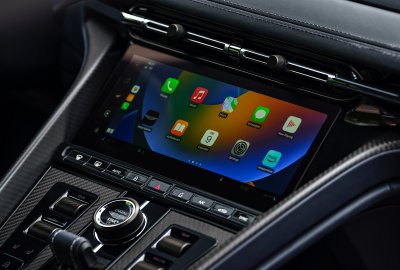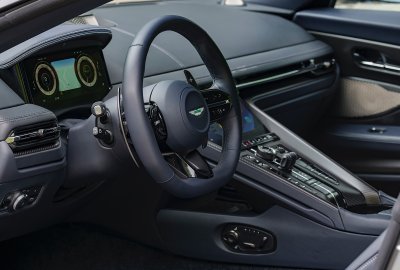The story of the Aston Martin brand is littered with failure. Numerous financial collapses, ownership changes and partnerships have brought the company to where it is today.
Over its century of existence, numerous familiar names have been tied into the Aston Martin legacy: Ford, Zagato, David Brown, Volvo and Land Rover among them.
In modern times, there are new names attached to Aston Martin Lagonda Global Holdings PLC: Yew Tree Overseas Limited, Mercedes-Benz Group, Saudi Arabia Public Investment Fund, Lucid Motors and Geely.
The future of Aston Martin is being defined today. It's being dictated by the models of the past, and an uncertain future in the rapidly evolving auto industry.
"I think one of the biggest challenges that's not unique to ask Aston, but certainly performance manufacturers, is on drivetrain," Alex Long, director of product and market strategy at Aston Martin told Newsweek.

"The evolution into electric ... guessing the time at which it will happen for all consumers is one thing, but what's started to happen is different segments are moving at different speeds ... Particularly if you look at sports cars versus, say, SUVs, the appetite for drivetrain change into electric is happening much more quickly in SUVs than it is in sports cars."
Aston Martin has relied on tried and true Mercedes-AMG powertrains for quite some time, but that doesn't mean that the super luxury automaker is resting on its laurels. The company's new partnership with Lucid Motors is designed to bring Lucid's battery-electric powertrain technology to the automaker as a portfolio of electric vehicles (EVs) is on the horizon.
Aston Martin's customer base isn't demanding all-electric all the time, right now. The automaker debuted and quickly sold out of its new 705-horsepower Valour, which has a twin-turbo V12 engine and six-speed manual transmission, earlier this year.
"[Valour] is pure play, combustion ... and then on the other hand, we all know the evolution we need to go through from an emissions point of view. So we have to have that development in background. By far and away, I think the hardest thing is the complexity of making the transition by segment and, and remaining successful in delivering what clients want at that particular point in time," Long said.







Pivoting is something that modern Aston Martin is quite used to. Alongside hypercars, sports cars, grand tourers and Formula One racers is the DBX, a two-row sport utility vehicle (SUV). Its market debut ushered in a new era for Aston in many ways, not the least of which is that it opened up a fresh consumer base.
"DBX has definitely changed our demographic. In a very short period of time, last two or three years or so, the average age of Aston buyers come down about seven years, which is a big shift," Long said.
Big swings like that are easier with a low volume manufacturer. Aston Martin sold just 6,412 vehicles in 2022, up 4 percent over 2021, but still below 2018 volumes. About half of Aston's sales were DBX SUVs.
Smaller volumes also allow Aston Martin's team to get to know their customers better, whether it's at the Goodwood Festival of Speed or a clinic. "We talk to them a lot about their intention and what their view is on what's coming next," Long said.

He revealed that Aston Martin's customers are telling them that they want the automaker to "deliver fun" and "something I'm passionate about something that rewards me". They see their Aston Martin as a treat.
"Post-COVID, there was a rush to energy and electrification ... That was the trend. It's really calmed down and then we're seeing some other trends around electrification happening less quickly. So it's definitely happening ... but at what pace you know?"
Though the pace of electrification adoption is not defined, Aston Martin is embracing the low-emissions future. A plug-in hybrid model, the Valhalla supercar, will come in 2024.
The company intends to have an electrified model range that spans hypercars, sports cars, grand tourers and SUVs. The first will launch in 2025 and the entire lineup will be fully electrified by 2030. By 2026, all new Aston Martin model lines will have an electrified powertrain option.






While the Lucid Motors partnership will come into play in those models, so will a continued Mercedes-Benz AG partnership, which will give Aston Martin access to powertrain and electric/electronic architectures for "current and future generation Aston Martin vehicles, including internal combustion engine, hybrid and electric vehicles" according to the automaker.
There's also a push toward refining the brand's biggest pain points. The number one complaint of current Aston owners? Infotainment. The new Aston Martin DB12 changes up design, materials and technology to deliver a fully modern product. That technology comes courtesy of a software stack that Aston engineers have designed themselves.
That DB12 is largely seen as a step forward into a new era for Aston Martin and a nod to what is to come.
Uncommon Knowledge
Newsweek is committed to challenging conventional wisdom and finding connections in the search for common ground.
Newsweek is committed to challenging conventional wisdom and finding connections in the search for common ground.
About the writer
Eileen Falkenberg-Hull leads the Autos team at Newsweek. She has written extensively about the auto industry for U.S. News & ... Read more
To read how Newsweek uses AI as a newsroom tool, Click here.





